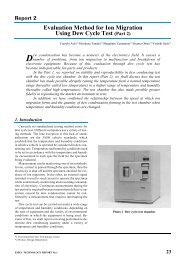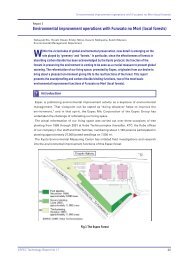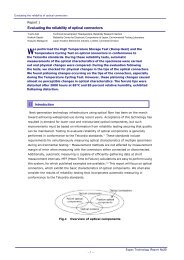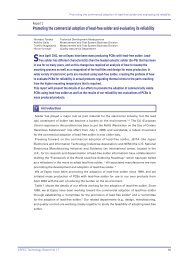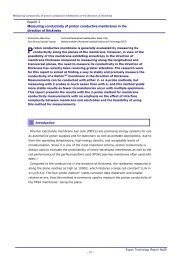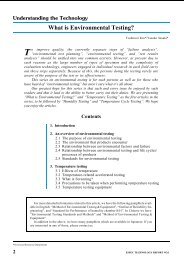download
download
download
You also want an ePaper? Increase the reach of your titles
YUMPU automatically turns print PDFs into web optimized ePapers that Google loves.
Measuring conductivity of proton conductive membranes in the direction of thickness<br />
[Terminology]<br />
*1.Cell constant<br />
Typically, electrical conductivity of a material can be expressed as<br />
σ=L/(A·R)=k/R, where L is the length (cm) of the material in electronic flow, A is<br />
the sectional area (cm2 ) across the flow of the material, R is the measured resistance<br />
(Ω), and k=L/A, the proportionality factor, is called the cell constant. The electrical<br />
conductivity of the material is in direct proportion to the reciprocal of the measured<br />
resistance between the electrodes by the scale factor, k, which represents the<br />
influence of the dimensions of the measuring cell.<br />
*2.Conductivity measurement using the 4-probe method<br />
As one method for measuring the electrical conductivity of materials, the 4-probe<br />
method possesses much higher measurement precision than the 2-probe method.<br />
Two terminals are used to conduct a current through the sample, and another two<br />
terminals measure the potential drop across the sample.<br />
*3.Proton-conductive membrane<br />
When potential difference exists in a conductor, electrical charges move in the<br />
direction required to weaken the difference. The property of this conductor is called<br />
its electrical conduction. When protons exist in the conductor as the main current<br />
carriers, the material is referred to as proton conduction, and the quality or power of<br />
the conduction is called proton conductivity. Some membrane materials, typically<br />
consisting of such as inorganic compounds of ceramics and/or glass, organic<br />
polymer compounds, and inorganic/organic hybrid materials, exhibit high H + ion<br />
conduction. Proton exchange membranes based on fluorinated polymers as typified<br />
by Nafion ® have been widely used in solid polymer electrolyte fuel cells (PEFCs) due<br />
to their high proton conductivity (to 0.1 Scm-1 ) and chemical stability.<br />
*4.Conductivity measurement using the 2-probe method<br />
As the simplest and most straightforward method for measuring electrical<br />
conductivity, the 2-probe method uses only two terminals that share the functions<br />
of both introduction of current (I) and measurement of voltage (V) across the<br />
sample. The electrical conductivity of a specimen can be calculated with the formula<br />
of σ=(I·L)/(V·A), provided that sectional area (A) and length (L) of the specimen are<br />
measured.<br />
*5.Membrane electrode assembly (MEA)<br />
An electrode layer composed of platinum black or platinum-supporting carbon and a<br />
porous supporting collector layer composed of carbon paper or carbon cloth<br />
arranged in succession on both sides of a cation exchange membrane, with the<br />
assembly unified by hot-pressing, is called a membrane electrode assembly (MEA).<br />
[Bibliography]<br />
1)http://www.fuelcells.dupont.com/<br />
2)Y. Sone, et al., J. Electrochem. Soc., 143, p.1254, 1996<br />
3)K. M. Cable et al., Chem. Mater., 7, p.1601, 1995<br />
4)A. Kuse, S. Ma, A. Mizugaki, H. Okuda, Z. Siroma, T. Ioroi, K. Yasuda, Y. Miyazaki;<br />
11th FCDIC Fuel Cell Symposium Proceedings, p.262, 2004<br />
- 20 -<br />
Espec Technology Report No20



